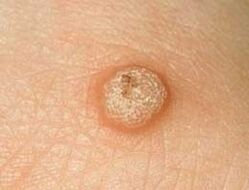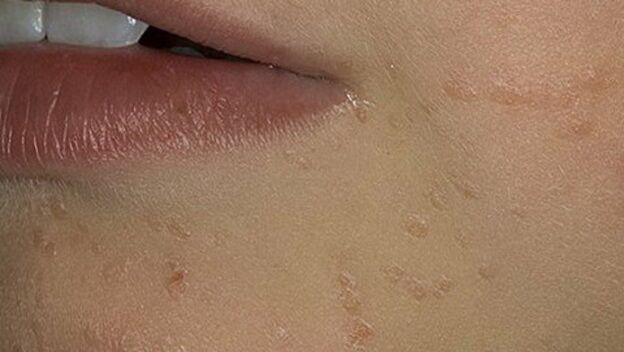Warts are benign (in contrast to malignant - without the formation of cancer cells) skin formations that are formed under the influence of various representatives of the human papillomavirus (HPV) family, of which there are more than a hundred. There are no gender and age barriers to warts: their prevalence is the same in both sexes and does not depend on age.
Ways of infection and causes of warts

The papillomavirus is transmitted by contact: either through direct contact with the carrier (handshake), or through contaminated household items and the environment (in baths, showers, swimming pools, etc. ). But don't be afraid of an outstretched hand from a colleague or good friend: the prerequisite for infection is an unfavorable combination of several factors:
- Skin tears and microtraumas, chronic scratches. Risk group - people engaged in wet cleaning or washing hands as a result of their professional activity: they have a lot of microtraumas on the skin;
- weak immunity (indicator - frequent colds);
- excessive sweating of hands and feet.
If everything went wrong, the first wart will appear in 1. 5-6 months: this is the incubation period of a viral infection caused by HPV.
Types and Symptoms of Warts
Common (even vulgar) warts
Such warts make up 2/3 of the total number of warts on the skin. Despite this, these warts are distinguished by age legibility: they often settle in children and younger schoolchildren.
A favorite place for wart dislocations are the hands (both palms and back), fingers, sometimes (which is very unpleasant from an aesthetic point of view) the face. The appearance of a vulgar wart is very unpretentious: a round seal nodule, ranging in size from a pinhead to a small pea. The color does not stand out on the skin. Individual warts are rare: there are usually several or a whole scattering. In addition, one of the warts is the largest, it is the so-called mother wart. If you eliminate it, the rest will come down by themselves.
Flat (juvenile) warts

Another representative of "young" warts that affects people from 10 to 25 years of age. They are small flat papules that protrude only slightly on the surface of the skin and have a smooth (sometimes scaly) surface. The color is flesh, sometimes withyellowish tint Most often flat warts are found on the backs of the hands, wrists, face and neck, sometimes - on the glans.
plantar warts

These warts are characterized by increased pain, which is felt especially when walking. Externally, plantar warts are difficult to distinguish from calluses. They can be either convex or concave. Plantar warts, true to their name, appear on the soles of the feet, in the areas of greatest friction.
Senile (seborrheic) warts

An epithelial benign tumor that forms over the years and appears with age is called a senile wart. It starts out as a small brown spot that increases in size over time, reaching 5-6 cm in diameter. The senile wart (also called seborrheic keratoma) has a greasy, crusted surface. Over time, it thickens, its surface becomes covered with cracks and literally fills with a dark brown color. Senile warts are formed on closed parts of the body, but sometimes they bother their unknowing owner on the face, neck and limbs.
condylomas (genital warts)
These warts have a specific localization: genitals, perineum, vaginal opening and anus. They can appear in the armpits, under the breasts in women, and in the nasolabial folds in children. Outwardly, due to their lobed structure, they are often compared to cockscomb or cauliflower. The color of warts is flesh-colored or pale pink, but if you rub them, they turn crimson and begin to bleed. They form large colonies.
diagnosis of warts
Diagnosing warts is not difficult, this is not rocket science for you. Just look at the clinical manifestations of these unwanted growths. Plantar warts differ from banal calluses in the papillary structure of the former, genital warts from wide warts, which are a sign of secondary syphilis, in their denser consistency, broad base and moist surface of the latter.
treatment of warts
Warts are removed either medically or mechanically. Due to their viral "essence" they are fought accordingly: antiviral ointments are prescribed. This will prevent warts from spreading to undeveloped areas. Of the folk methods, the milky sap of celandine, which stands out on the cut of the plant, has become widespread.
Electrocoagulation (exposure to electric current + high temperature) helps to get rid of warts even in the most advanced cases.
Cryotherapy (cryodestruction with liquid nitrogen) is very suitable for treating vulgar warts. This procedure is virtually painless, which makes it suitable for children.
Plantar warts are treated in a complex way: first - by cryodestruction, then - surgically, removing the affected tissue area under local anesthesia.
Laser therapy, which uses different types of rays, is also used. The affected area depends on it evaporating or coagulating.
Usually there are no special problems with warts, but relapses do occur. And in about half the cases, they go away on their own, without treatment.
As a preventive measure, it can be recommended to immediately react to the appearance of even a single wart and immediately take measures to eliminate it.

























